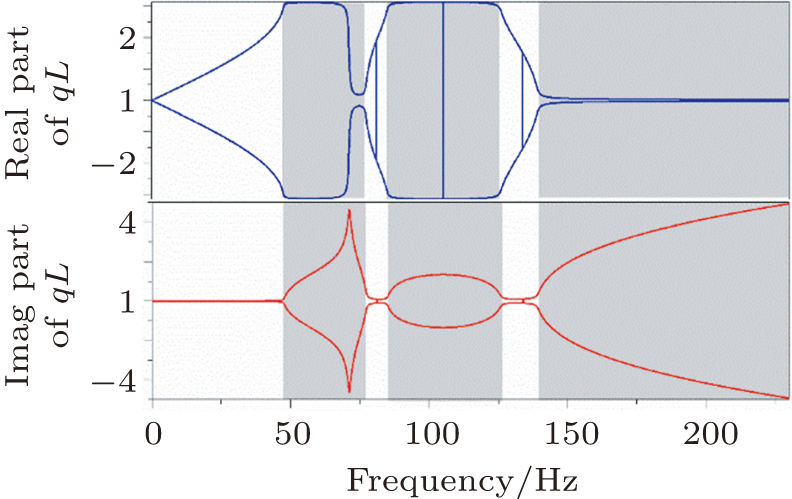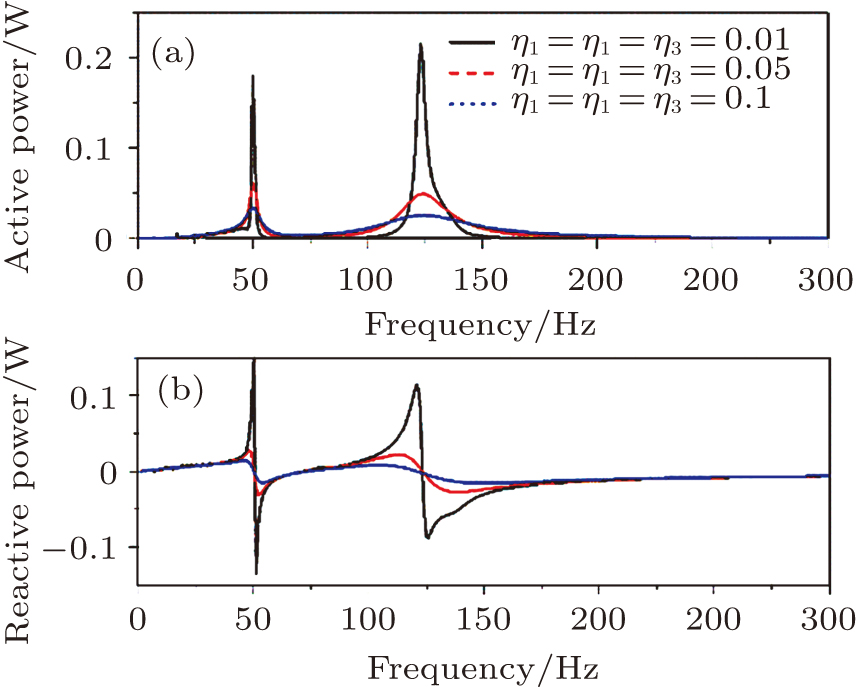† Corresponding author. E-mail:
To reveal the energy transmission through a hybrid phononic crystal structure, power flow analysis is carried out in this paper. Hysteretic damping having significant relationship with power flow is added and corresponding theoretical formulas of the dispersion relation are derived. Besides, the power flow in the hybrid structure is calculated by using the finite element method. The results show that as the damping increases, the boundaries of the band gaps become smoother and dimmer, i.e., broader width. With the increase of damping, the power flow is lowered at the resonance frequencies, while slightly increases near the resonance frequencies. The power flow maps manifest energy distribution in the hybrid structure within and out of the band gaps, which can be exploited in the optimization of the structure design.
Phononic crystal is a novel kind of artificial periodic structure which shows unique properties to block elastic waves. Several phononic crystal configurations have been constructed, such as mass in mass,[1] parallel masses connected by springs,[2] torsional mass in mass,[3] and so on. Simultaneously, various methods such as plane wave expansion[4] and matrix transfer methods[5] have been developed to calculate the dispersion relation of the elastic waves propagation in phononic crystals. In analysis, the band gaps that are specific frequency ranges within which the elastic waves are dramatically attenuated are the main concern and have potential in the field of noise and vibration control.
There are two main basic mechanisms for the band gaps, Bragg scattering and local resonance. Generally, phononic crystals are just based on one of the mechanisms.[6] Hybrid structures based on both mechanisms are rarely mentioned, let alone the compound characteristics. Zhang[7] presented a hybrid structure by attaching pillars to a plate with periodic holes. A low-frequency band gap was achieved. Krushynska[8] exploited coupled Bragg scattering and local resonance to construct a mechanical metamaterial, and analyzed its band gap performance. Analysis on the hybrid phononic crystals showed good band gap properties. Based on the published literature, a hybrid structure[9] was proposed based on both mechanisms. The dispersion relation was studied by varying the stiffness ratio and mass ratio to optimize the band gaps. To better implement the hybrid structure in practical engineering, further analysis needs to be conducted. Since damping is a factor which cannot be ignored in practical engineering, its influence on the band gaps and wave propagation should be paid attention to. Therefore, a thorough investigation of the hybrid structure with damping is conducted in this paper.
It is well known that power flow analysis is an effective method to describe the energy flow and wave transmission paths in vibrating structures.[10] Pavic[11] studied the effects of structural damping on energy flow and found that the temporal mean value of the total vibratory power input is proportional to the product of the loss factor and the global potential energy. Petrone[12] presented experimental and numerical predictions for power flow in a rectangular plate to reduce the vibration levels. Cho et al.[13] assessed the magnitude and direction of vibration energy flow on dominant transmission paths and the vibratory energy distribution including sink positions by utilizing power flow analysis. However, such a powerful method is rarely used in the analysis of phononic crystals.[14]
In this paper, inheriting the previous study on a hybrid structure,[9] damping effects on the dispersion relation and power flow analysis are both investigated. Theoretical derivation and numerical simulation are presented in Sections
Figure 


 |
 |
 |

 |
 |
Substitution of Eqs. (
 |
| Table 1.
Parameters used in the calculation. . |
Figures 



In the meantime, there exists an asymmetry in Fig.
Through the analysis in this section, we have better understanding of the damping influence on the band gaps, which provides guidance in design of phononics in practical engineering that needs large band gaps to reduce annoying vibrations.
Power flow analysis is a powerful technique to determine the energy flow paths and further provide guidance in structure design. It is first chosen as an alternative method to calculate the stop bands in periodic structures in Ref. [14]. Power flow maps and energy flow among attachments and the main structure show clear vibration paths and help researchers determine the largest energy convergence point. In this work, we want to utilize the useful approach to analyze the power flow in the hybrid phononic crystal structure.
The complex transmitting power can be expressed as follows from the exciting force and structureʼs velocity under a steady-state harmonic analysis:
 |


A harmonic force is assumed to be applied on a 50-unit-cell system, with motion equation
 |
 |
 |
 |
 |
 |
This section aims at solving equations referred to the structural power flow by using finite element method. Therefore, the finite element model of the hybrid structure of 100 unit cells has been established with parameters listed in Table 

Firstly, the input structural power flow is calculated with damping of η1 = 0.01, η2 = 0.01, and η3 = 0.01, as shown in Fig.
Power flow maps denote the flow direction along the length of one dimensional structures via directional arrows, which simultaneously depict the amplitude of the active power flow.[15] In such a way, consecutive arrows come out from the excitation point and the length of the arrowheads represents the active power flow at different locations. In this paper, the active power flow maps are drawn through a histogram with directions being negative values. The calculation is based on the parameters in Table 
In Fig.
Figure
In Fig.
We analyze the damping effect on the dispersion relation and power flow through a hybrid structure composed of a local resonance and an outer resonance. Theoretical investigation and numerical simulation show that, for band gaps, the damping functions positively, while the attenuation within the band gaps is reduced as the damping increases; for power flow, the product of displacement and damping, it is complicated due to the response dependence on the damping. When small damping is exploited, the responses at resonance frequencies may be maxima, which results in large power flow. As the damping increases, the responses are lowered, so is the power flow. The power flow maps also reveal that within the band gaps, the power flow is dramatically blocked, while out of the band gaps, the power can flow through the hybrid structure like fluid flow. Analysis in this paper provides an alternative mechanism of the hybrid structure which has potential in the field of noise and vibration control.
| [1] | |
| [2] | |
| [3] | |
| [4] | |
| [5] | |
| [6] | |
| [7] | |
| [8] | |
| [9] | |
| [10] | |
| [11] | |
| [12] | |
| [13] | |
| [14] | |
| [15] |












